The global reactive brominated flame retardants market is valued at USD 546.9 million in 2025 and is set to reach USD 934.2 million by 2035, recording an absolute increase of USD 387.3 million over the forecast period. This translates into a total growth of 70.8%, with the reactive brominated flame retardants market forecast to expand at a compound annual growth rate (CAGR) of 5.5% between 2025 and 2035. The overall market size is expected to grow by approximately 1.7X during the same period, supported by increasing fire safety regulations, growing demand for enhanced thermal protection systems, and rising requirements for chemical-reactive flame retardant solutions across construction, plastics manufacturing, rubber processing, and electronics sectors.
The global reactive brominated flame retardants market is a specialized segment within the chemical additives and fire protection industry, driven by the superior flame-inhibition properties of brominated compounds and the chemical bonding capabilities of reactive formulations. These specialized additives operate through halogen-based flame suppression mechanisms, providing effective fire retardancy and thermal decomposition control for various polymer matrices, including thermoplastics, thermosets, polyurethane foams, and synthetic rubber compounds. The reactive mechanism enables permanent chemical integration into polymer chains, eliminating migration issues and maintaining consistent fire protection performance throughout material service life.
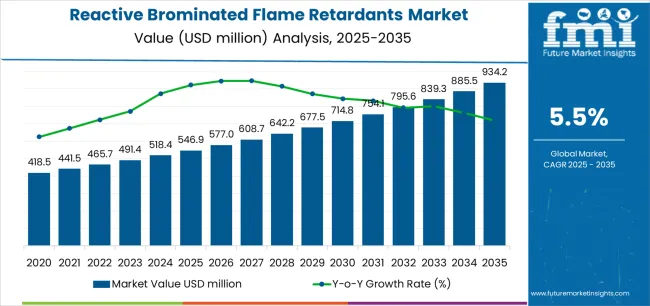
The reactive brominated flame retardants market encompasses various molecular configurations, bromination levels, and specialized formulations tailored for specific application requirements in fire-sensitive materials. Modern reactive brominated flame retardants incorporate advanced synthesis methodologies, improved thermal stability characteristics, and enhanced compatibility profiles that can withstand demanding processing conditions while maintaining consistent performance over extended operational periods. The integration of synergistic systems, controlled-release mechanisms, and multifunctional additive packages has further enhanced the performance profile of these chemical systems among material manufacturers seeking comprehensive fire protection and processing efficiency.
Market dynamics are significantly influenced by stringent building codes, fire safety regulations, and material certification requirements, particularly in construction applications, transportation materials, and electronic component manufacturing where fire resistance and flame spread prevention are critical. The materials sector's increasing emphasis on fire-safe design, regulatory compliance, and liability reduction has created substantial demand for high-performance flame retardant solutions in polymer processing, foam manufacturing, and composite fabrication systems. The growing trend toward advanced material engineering and performance-based fire protection has amplified the need for chemically-reactive additive systems capable of providing permanent integration with host materials and enhanced fire protection characteristics.
Consumer purchasing patterns show a marked preference for reactive systems that combine effective flame retardancy with minimal impact on material properties, processing compatibility, and long-term durability across diverse polymer applications. The reactive brominated flame retardants market has witnessed significant technological advancement in molecular design, synthesis processes, and additive integration methods, making these compounds more suitable for high-temperature processing, demanding applications, and environmentally-conscious manufacturing environments.
Between 2025 and 2030, the reactive brominated flame retardants market is projected to expand from USD 546.9 million to USD 714.8 million, resulting in a value increase of USD 167.9 million, which represents 43.4% of the total forecast growth for the decade. This phase of development will be shaped by increasing fire safety compliance requirements, rising demand for chemical-reactive flame retardant solutions, and growing availability of advanced brominated synthesis technologies across polymer manufacturing facilities and material processing applications.
Between 2030 and 2035, the reactive brominated flame retardants market is forecast to grow from USD 714.8 million to USD 934.2 million, adding another USD 219.4 million, which constitutes 56.6% of the overall ten-year expansion. This period is expected to be characterized by the advancement of next-generation reactive formulations, the development of environmentally optimized brominated systems for specialized applications, and the expansion of high-performance additive networks across diverse material processing and manufacturing applications. The growing emphasis on permanent fire protection and processing optimization will drive demand for advanced reactive varieties with enhanced thermal stability characteristics, improved polymer compatibility profiles, and superior flame retardancy performance capabilities.
Between 2020 and 2024, the reactive brominated flame retardants market experienced steady growth, driven by increasing fire safety awareness and growing recognition of reactive systems' superior performance in permanent flame protection following extensive industry validation programs. The reactive brominated flame retardants market developed as manufacturers recognized the advantages of reactive brominated systems over additive alternatives in long-term applications and began seeking specialized solutions designed for permanent polymer integration requirements. Technological advancement in synthesis processes and formulation technologies began emphasizing the critical importance of maintaining chemical bonding efficiency while enhancing flame retardancy effectiveness and improving material compatibility across diverse polymer processing applications.
| Metric | Value |
|---|---|
| Estimated Value in (2025E) | USD 546.9 million |
| Forecast Value in (2035F) | USD 934.2 million |
| Forecast CAGR (2025 to 2035) | 5.5% |
From 2030 to 2035, the reactive brominated flame retardants market is forecast to grow from USD 714.8 million to USD 934.2 million, adding another USD 219.4 million, which constitutes 56.6% of the overall ten-year expansion. This period is expected to be characterized by the advancement of smart additive integration systems, the integration of real-time performance monitoring for optimal flame protection assessment, and the development of specialized formulations for high-performance material applications. The growing emphasis on processing efficiency and flame retardancy reliability will drive demand for premium varieties with enhanced chemical reactivity capabilities, improved thermal performance characteristics, and superior material integration profiles.
Between 2020 and 2024, the reactive brominated flame retardants market experienced robust growth, driven by increasing awareness of fire-related material failures and growing recognition of specialized additive systems' effectiveness in supporting reliable fire protection across polymer manufacturing facilities and material processing applications. The reactive brominated flame retardants market developed as users recognized the potential for reactive brominated systems to deliver fire protection advantages while meeting modern requirements for permanent material integration and reliable flame suppression performance. Technological advancement in molecular engineering and synthesis optimization began emphasizing the critical importance of maintaining chemical efficiency while extending protection duration and improving user satisfaction across diverse flame retardant applications.
Market expansion is being supported by the increasing global emphasis on fire safety compliance and the corresponding shift toward high-performance flame retardant systems that can provide superior chemical bonding characteristics while meeting user requirements for permanent fire protection and cost-effective processing solutions. Modern material manufacturers are increasingly focused on incorporating additive systems that can enhance fire safety performance while satisfying demands for consistent, permanently-integrated flame protection and optimized processing efficiency practices. Reactive brominated flame retardants' proven ability to deliver chemical integration excellence, flame suppression benefits, and diverse application possibilities makes them essential components for safety-focused manufacturers and quality-focused material processing professionals.
The growing emphasis on regulatory compliance and material safety standards is driving demand for high-performance flame retardant systems that can support distinctive fire protection outcomes and comprehensive safety management across polymer processing, material manufacturing, and premium industrial installations. User preference for additive solutions that combine functional excellence with permanent integration is creating opportunities for innovative implementations in both traditional and emerging fire protection applications. The rising influence of advanced material technologies and enhanced safety monitoring systems is also contributing to increased adoption of reactive flame retardant solutions that can provide authentic fire protection benefits and reliable performance monitoring characteristics.
The reactive brominated flame retardants market is segmented by type, application, molecular weight, reactivity level, and region. By type, the reactive brominated flame retardants market is divided into tetrabromobisphenol A, tribromophenol, tetrabromophthalic anhydride diol, and other reactive formulations. Based on application, the reactive brominated flame retardants market is categorized into the construction industry, plastics industry, rubber industry, electronics manufacturing, and others. By molecular weight, the reactive brominated flame retardants market includes low molecular weight, medium molecular weight, and high molecular weight categories. By reactivity level, the reactive brominated flame retardants market encompasses standard reactivity, enhanced reactivity, and specialized reactivity configurations. Regionally, the reactive brominated flame retardants market is divided into North America, Europe, Asia Pacific, Latin America, Middle East & Africa, and other regions.
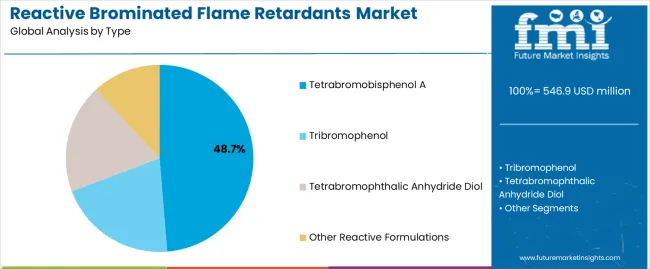
The tetrabromobisphenol A segment is projected to account for 48.7% of the reactive brominated flame retardants market in 2025, reaffirming its position as the leading type category. Material manufacturers and processing professionals increasingly utilize tetrabromobisphenol A systems for their superior flame retardancy characteristics, established performance standards, and essential functionality in diverse reactive integration applications across multiple polymer sectors. Tetrabromobisphenol A compounds' proven performance characteristics and established cost-effectiveness directly address user requirements for reliable flame protection and optimal chemical reactivity in material processing and manufacturing applications.
This type segment forms the foundation of modern flame retardancy performance patterns, as it represents the chemical configuration with the greatest application versatility and established compatibility across multiple polymer processing systems. Industrial investments in advanced synthesis technology and performance optimization continue to strengthen adoption among safety-focused users. With manufacturers prioritizing fire protection consistency and chemical reliability, tetrabromobisphenol A systems align with both efficiency objectives and performance requirements, making them the central component of comprehensive flame retardancy strategies.

Construction Industry is projected to represent 41.6% of the reactive brominated flame retardants market in 2025, underscoring its critical role as the primary application for safety-focused users seeking superior fire protection benefits and enhanced building material performance credentials. Construction users and material specifiers prefer construction applications for their established fire safety requirements, proven performance demand, and ability to maintain exceptional flame retardancy while supporting versatile material coverage during diverse building activities. Positioned as essential applications for compliance-focused manufacturers, construction offerings provide both fire protection excellence and regulatory compliance advantages.
The segment is supported by continuous improvement in building technology and the widespread availability of established construction standards that enable performance assurance and premium positioning at the manufacturing level. Construction users are optimizing additive selections to support application-specific requirements and comprehensive building safety strategies. As fire safety technology continues to advance and manufacturers seek efficient protection methods, construction applications will continue to drive market growth while supporting fire protection efficiency and regulatory compliance strategies.
The reactive brominated flame retardants market is advancing rapidly due to increasing fire safety regulation adoption and growing need for chemical-reactive flame protection solutions that emphasize superior flame suppression performance across material manufacturing segments and polymer processing applications. The reactive brominated flame retardants market faces challenges, including competition from alternative flame retardant technologies, environmental considerations affecting formulation development, and processing compatibility factors affecting adoption rates. Innovation in molecular engineering enhancement and advanced synthesis methodologies continues to influence market development and expansion patterns.
The growing adoption of reactive brominated flame retardants with advanced polymer compatibility and high-performance material integration is enabling users to develop fire protection strategies that provide distinctive flame suppression benefits while commanding permanent chemical bonding and enhanced long-term performance analysis characteristics. High-performance applications provide superior fire protection consistency while allowing more sophisticated material optimization features across various polymer categories. Users are increasingly recognizing the operational advantages of reactive additive positioning for comprehensive fire safety outcomes and technology-integrated material management.
Modern reactive brominated flame retardant manufacturers are incorporating advanced environmental considerations, optimized synthesis processes, and enhanced processing compatibility systems to improve fire protection precision, enhance material processing effectiveness, and meet industrial demands for efficient flame retardant solutions. These systems improve processing effectiveness while enabling new applications, including controlled-release protection programs and automated integration protocols. Advanced environmental optimization also allows users to support regulatory compliance positioning and performance assurance beyond traditional flame retardant operation requirements.
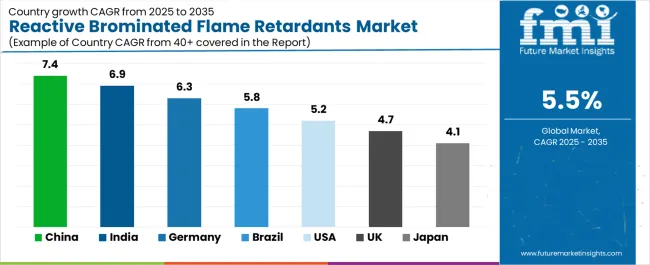
| Country | CAGR (2025-2035) |
|---|---|
| China | 7.4% |
| India | 6.9% |
| Germany | 6.3% |
| Brazil | 5.8% |
| USA | 5.2% |
| UK | 4.7% |
| Japan | 4.1% |
The reactive brominated flame retardants market is experiencing robust growth globally, with China leading at a 7.4% CAGR through 2035, driven by the expanding construction sector, growing fire safety regulation requirements, and increasing adoption of advanced flame retardant systems. India follows at 6.9%, supported by rising industrialization, expanding polymer processing industry, and growing acceptance of fire safety technologies. Germany shows growth at 6.3%, emphasizing established chemical standards and comprehensive material safety development. Brazil records 5.8%, focusing on construction modernization and fire protection efficiency growth. The USA demonstrates 5.2% growth, prioritizing advanced fire safety technologies and regulatory optimization.
The report covers an in-depth analysis of 40+ countries; seven top-performing countries are highlighted below.
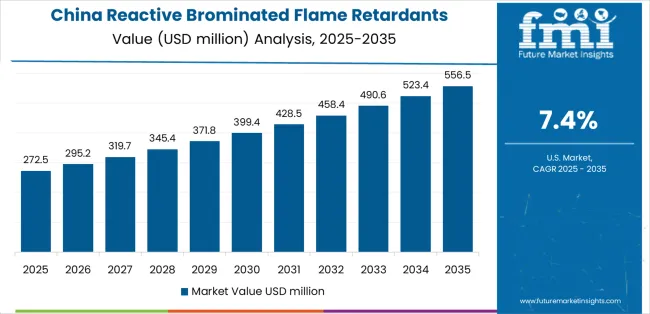
Revenue from reactive brominated flame retardants consumption and sales in China is projected to exhibit exceptional growth with a CAGR of 7.4% through 2035, driven by the country's rapidly expanding construction sector, favorable government policies toward building safety modernization, and initiatives promoting fire protection technologies across major industrial regions. China's position as a global construction hub and increasing focus on fire safety optimization systems are creating substantial demand for high-quality reactive brominated flame retardants in both domestic and export markets. Major chemical companies and additive distributors are establishing comprehensive flame retardant capabilities to serve growing demand and emerging safety opportunities.
Revenue from reactive brominated flame retardant products in India is expanding at a CAGR of 6.9%, supported by rising construction investment, growing fire safety consciousness, and expanding chemical distributor capabilities. The country's developing industrial infrastructure and increasing investment in safety technologies are driving demand for flame retardants across both traditional and modern construction applications. International chemical companies and domestic distributors are establishing comprehensive operational networks to address growing market demand for fire protection devices and efficient safety solutions.
Revenue from reactive brominated flame retardant products in Germany is projected to grow at a CAGR of 6.3% through 2035, supported by the country's mature chemical standards, established fire safety regulations, and leadership in precision material technology. Germany's sophisticated chemical standards and strong support for advanced fire protection systems are creating steady demand for both traditional and innovative flame retardant varieties. Leading chemical manufacturers and specialty distributors are establishing comprehensive operational strategies to serve both domestic markets and growing export opportunities.
Revenue from reactive brominated flame retardant products in Brazil is projected to grow at a CAGR of 5.8% through 2035, driven by the country's emphasis on construction development, building modernization growth, and growing chemical distributor capabilities. Brazilian construction users and manufacturing facilities consistently seek safety-focused chemicals that enhance fire protection and support modernization excellence for both traditional and modern building applications. The country's position as a Latin American construction leader continues to drive innovation in specialized fire protection applications and building safety standards.
Revenue from reactive brominated flame retardant products in the USA is projected to grow at a CAGR of 5.2% through 2035, supported by the country's emphasis on material technology advancement, fire safety optimization, and advanced protection system integration requiring efficient flame retardant solutions. American construction users and safety-focused facilities prioritize performance reliability and fire protection precision, making specialized reactive brominated flame retardants essential components for both traditional and modern fire safety applications. The country's comprehensive material technology leadership and advancing safety patterns support continued market expansion.
Revenue from reactive brominated flame retardant products in the UK is projected to grow at a CAGR of 4.7% through 2035, supported by established building standards, mature construction markets, and emphasis on fire protection reliability across manufacturing and construction sectors. British construction users and safety professionals prioritize quality performance and fire protection consistency, creating steady demand for premium flame retardant solutions. The country's comprehensive market maturity and established building practices support continued development in specialized applications.

Revenue from reactive brominated flame retardant products in Japan is projected to grow at a CAGR of 4.1% through 2035, supported by the country's emphasis on precision manufacturing, fire protection excellence, and advanced technology integration requiring efficient flame retardant solutions. Japanese construction users and safety-focused facilities prioritize technical performance and manufacturing precision, making specialized reactive brominated flame retardants essential components for both traditional and modern fire protection applications. The country's comprehensive manufacturing leadership and advancing precision patterns support continued market expansion.
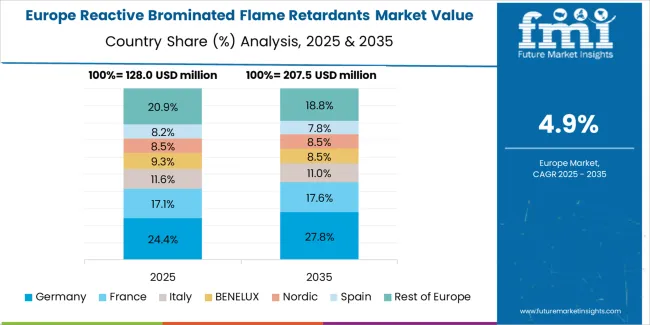
The Europe reactive brominated flame retardants market is projected to grow from USD 154.8 million in 2025 to USD 264.3 million by 2035, recording a CAGR of 5.5% over the forecast period. Germany leads the region with a 39.4% share in 2025, moderating slightly to 38.9% by 2035, supported by its strong chemical traditions and demand for premium, precision-manufactured flame retardant solutions. The United Kingdom follows with 24.2% in 2025, easing to 23.7% by 2035, driven by a mature construction market and emphasis on fire protection reliability and quality performance. France accounts for 16.3% in 2025, rising to 16.8% by 2035, reflecting steady adoption of fire safety technologies and material optimization. Italy holds 8.7% in 2025, expanding to 9.4% by 2035 as construction modernization and specialty safety applications grow. Spain contributes 5.9% in 2025, growing to 6.3% by 2035, supported by expanding construction development and safety awareness modernization. The Nordic countries rise from 3.4% in 2025 to 3.6% by 2035 on the back of strong chemical consciousness and advanced manufacturing methodologies. BENELUX remains at 2.1% share across both 2025 and 2035, reflecting mature, safety-focused construction markets.

The reactive brominated flame retardants market is characterized by competition among established chemical manufacturers, specialized additive companies, and integrated fire protection providers. Companies are investing in advanced synthesis technologies, specialized molecular engineering, product innovation capabilities, and comprehensive distribution networks to deliver consistent, high-quality, and reliable flame retardant systems. Innovation in chemical reactivity optimization, synthesis technology advancement, and safety-focused product development is central to strengthening market position and customer satisfaction.
Jordan Bromine leads the reactive brominated flame retardants market with a strong focus on bromine chemistry innovation and comprehensive flame retardant solutions, offering industrial and construction systems with emphasis on performance excellence and chemical heritage. ICL-IP provides integrated chemical processing with a focus on industrial market applications and precision additive networks. Lanxess delivers comprehensive chemical technology solutions with a focus on industrial positioning and processing efficiency. Albemarle specializes in comprehensive specialty chemicals with an emphasis on fire protection applications. Manac focuses on comprehensive chemical manufacturing with advanced design and premium positioning capabilities.
The success of reactive brominated flame retardants in meeting fire safety demands, material protection requirements, and regulatory integration will not only enhance fire protection outcomes but also strengthen global chemical technology manufacturing capabilities. It will consolidate emerging regions' positions as hubs for efficient flame retardant production and align advanced economies with comprehensive fire safety systems. This calls for a concerted effort by all stakeholders -- governments, industry bodies, manufacturers, distributors, and investors. Each can be a crucial enabler in preparing the reactive brominated flame retardants market for its next phase of growth.
How Governments Could Spur Local Production and Adoption?
How Industry Bodies Could Support Market Development?
How Distributors and Chemical Players Could Strengthen the Ecosystem?
How Manufacturers Could Navigate the Shift?
| Items | Values |
|---|---|
| Quantitative Units (2025) | USD 546.9 million |
| Type | Tetrabromobisphenol A, Tribromophenol, Tetrabromophthalic Anhydride Diol, Other Reactive Formulations |
| Application | Construction Industry, Plastics Industry, Rubber Industry, Electronics Manufacturing, Others |
| Molecular Weight | Low Molecular Weight, Medium Molecular Weight, High Molecular Weight |
| Reactivity Level | Standard Reactivity, Enhanced Reactivity, Specialized Reactivity |
| Regions Covered | North America, Europe, Asia Pacific, Latin America, Middle East & Africa, Other Regions |
| Countries Covered | China, India, Germany, Brazil, United States, United Kingdom, Japan, and 40+ countries |
| Key Companies Profiled | Jordan Bromine, ICL-IP (ICL Group), Lanxess, Albemarle Corporation |
| Additional Attributes | Dollar sales by type, application, molecular weight, reactivity level, and region; regional demand trends, competitive landscape, technological advancements in chemical engineering, synthesis optimization initiatives, fire safety enhancement programs, and premium product development strategies |
The global reactive brominated flame retardants market is estimated to be valued at USD 546.9 million in 2025.
The market size for the reactive brominated flame retardants market is projected to reach USD 934.2 million by 2035.
The reactive brominated flame retardants market is expected to grow at a 5.5% CAGR between 2025 and 2035.
The key product types in reactive brominated flame retardants market are tetrabromobisphenol a, tribromophenol, tetrabromophthalic anhydride diol and other reactive formulations.
In terms of application, construction industry segment to command 41.6% share in the reactive brominated flame retardants market in 2025.






Full Research Suite comprises of:
Market outlook & trends analysis
Interviews & case studies
Strategic recommendations
Vendor profiles & capabilities analysis
5-year forecasts
8 regions and 60+ country-level data splits
Market segment data splits
12 months of continuous data updates
DELIVERED AS:
PDF EXCEL ONLINE
Reactive Hot Melt Adhesive Market Forecast Outlook 2025 to 2035
Reactive Arthritis Treatment Market Size and Share Forecast Outlook 2025 to 2035
Reactive Tire Bladder Release Agent Market Size and Share Forecast Outlook 2025 to 2035
Reactive Diluents Market Growth – Trends & Forecast 2022 to 2032
Reactive Softeners (Textile Industry) Market
C-Reactive Protein Analyzers Market
Highly Reactive Polyisobutylene HR PIB Market Size and Share Forecast Outlook 2025 to 2035
Brominated Vegetable Oil Market Size and Share Forecast Outlook 2025 to 2035
Polymeric Brominated Flame Retardants Market Size and Share Forecast Outlook 2025 to 2035
Small Molecule Brominated Flame Retardants Market Size and Share Forecast Outlook 2025 to 2035
Flame Detector Market Size and Share Forecast Outlook 2025 to 2035
Flameproof Equipment Market Size and Share Forecast Outlook 2025 to 2035
Flame Barrier Market Size and Share Forecast Outlook 2025 to 2035
Flame Resistant Fabrics Market Size and Share Forecast Outlook 2025 to 2035
Flame Retardant Masterbatch Market Size and Share Forecast Outlook 2025 to 2035
Flame Photometer Market Size and Share Forecast Outlook 2025 to 2035
Flame Ionization Detectors Market Size and Share Forecast Outlook 2025 to 2035
Flame Proof Lighting Market Growth 2025 to 2035
Flame Retardant Chemicals Market Growth - Trends & Forecast 2025 to 2035
Flame Retardant Film Market Analysis & Forecast 2024-2034

Thank you!
You will receive an email from our Business Development Manager. Please be sure to check your SPAM/JUNK folder too.
Chat With
MaRIA